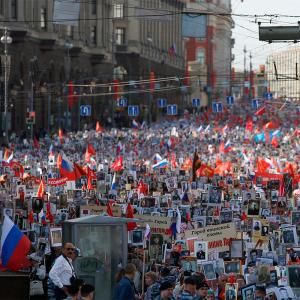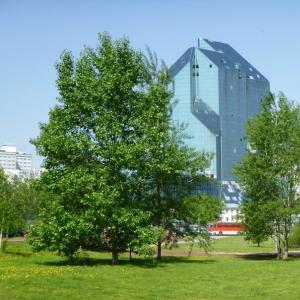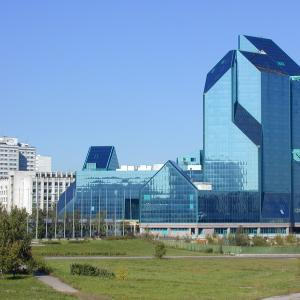We compose the reaction equations for the compounds. How to make a chemical equation: rules, examples
Reactions between different kinds of chemicals and elements are one of the main subjects of study in chemistry. To understand how to compose the reaction equation and use them for your own purposes, you need a fairly deep understanding of all the laws governing the interaction of substances, as well as processes with chemical reactions.
Drawing up equations
One of the ways to express a chemical reaction is a chemical equation. It records the formula of the initial substance and the product, coefficients that show how many molecules each substance has. All known chemical reactions are divided into four types: substitution, combination, exchange and decomposition. Among them, there are: redox, exogenous, ionic, reversible, irreversible, etc.
Learn more about how to write equations chemical reactions:
- It is necessary to determine the name of the substances interacting with each other in the reaction. We write them on the left side of our equation. As an example, consider the chemical reaction that formed between sulfuric acid and aluminum. Place the reagents on the left: H2SO4 + Al. Next, we write the "equal" sign. In chemistry, you can see the sign "arrow", which points to the right, or two opposite arrows, they mean "reversibility." The result of the interaction of a metal and an acid is salt and hydrogen. Write down the products obtained after the reaction after the equal sign, that is, on the right. H2SO4 + Al \u003d H2 + Al2 (SO4) 3. So, we see the scheme of the reaction.
- To draw up a chemical equation, you must find the coefficients. Let's go back to the previous scheme. Let's look at the left side of it. Sulfuric acid contains atoms of hydrogen, oxygen and sulfur, in an approximate ratio of 2: 4: 1. On the right side there are 3 sulfur atoms and 12 oxygen atoms in the salt. Two hydrogen atoms are contained in a gas molecule. On the left, the ratio of these elements is 2: 3: 12
- To equalize the number of oxygen and sulfur atoms, which are in the composition of aluminum (III) sulfate, it is necessary to put a coefficient 3 in front of the acid in the left side of the equation. Now we have 6 hydrogen atoms on the left side. In order to equalize the number of hydrogen elements, you need to put 3 in front of hydrogen on the right side of the equation.
- Now it remains only to equalize the amount of aluminum. Since the salt contains two metal atoms, then on the left side in front of aluminum we set the coefficient 2. As a result, we get the reaction equation of this scheme: 2Al + 3H2SO4 \u003d Al2 (SO4) 3 + 3H2
Having understood the basic principles of how to compose the equation for the reaction of chemicals, in the future it will not be difficult to write down any, even the most exotic, from the point of view of chemistry, reaction.
Class: 8
Lesson presentation
Back forward
Attention! The slide preview is used for informational purposes only and may not represent all the presentation options. If you are interested in this work, please download the full version.
The purpose of the lesson: help students to form knowledge about a chemical equation as a conditional recording of a chemical reaction using chemical formulas.
Tasks:
Educational:
- systematize previously studied material;
- teach the ability to draw up equations of chemical reactions.
Educational:
- to develop communication skills (work in pairs, the ability to listen and hear).
Developing:
- to develop educational and organizational skills aimed at accomplishing the assigned task;
- develop analytical thinking skills.
Lesson type: combined.
Equipment: computer, multimedia projector, screen, score sheets, reflection map, “set of chemical signs”, notebook with a printed base, reagents: sodium hydroxide, iron (III) chloride, spirit lamp, holder, matches, Whatman paper, multicolored chemical signs.
Lesson presentation (Appendix 3)
Lesson structure.
І. Organizing time.
II. Updating knowledge and skills.
ІІІ. Motivation and goal setting.
IV. Learning new material:
4.1 reaction of combustion of aluminum in oxygen;
4.2 the reaction of decomposition of iron (III) hydroxide;
4.3 algorithm for placing odds;
4.4 minute of relaxation;
4.5 place the odds;
V. Consolidation of the acquired knowledge.
VІ. Summing up the lesson and assigning marks.
VІІ. Homework.
VІІІ. Closing remarks from the teacher.
During the classes
The chemical nature of a complex particle
determined by the nature of elementary
component parts,
their number and
chemical structure.
D.I. Mendeleev
Teacher. Hello guys. Sit down.
Please note: you have a notebook with a printed base on your desk (Appendix 2), in which you will work today, and an assessment sheet, in which you will record your achievements, sign it.
Updating knowledge and skills.
Teacher. We got acquainted with physical and chemical phenomena, chemical reactions and signs of their course. Studied the law of conservation of mass of substances.
Let's put your knowledge to the test. I suggest you open notebooks with a printed basis and complete task 1. You are given 5 minutes to complete the task.
Test on the topic “Physical and chemical phenomena. The law of conservation of mass of substances ”.
1. How are chemical reactions different from physical phenomena?
- Change of shape, aggregate state substances.
- Formation of new substances.
- Change of location.
2. What are the signs of a chemical reaction?
- Sediment formation, discoloration, gas evolution.
3. In accordance with what law are the equations of chemical reactions?
- The law of the constancy of the composition of matter.
- The law of conservation of mass of matter.
- Periodic law.
- The law of dynamics.
- The law of universal gravitation.
4. The law of conservation of mass of matter discovered:
- DI. Mendeleev.
- Charles Darwin.
- M.V. Lomonosov.
- I. Newton.
- A.I. Butlerov.
5. The chemical equation is called:
- Conditional notation of a chemical reaction.
Teacher. You have done the job. I suggest you check it out. Swap notebooks and cross-check. Attention to the screen. For each correct answer - 1 point. Enter the total score on the score sheets.
Motivation and goal setting.
Teacher.Using this knowledge, today we will compose the equations of chemical reactions, revealing the problem "Is the law of conservation of mass of substances the basis for drawing up the equations of chemical reactions"
Learning new material.
Teacher. We are used to thinking that an equation is a mathematical example where there is an unknown and this unknown needs to be calculated. But in chemical equations, usually nothing unknown happens: they simply write everything in formulas: what substances enter into a reaction and what are obtained in the course of this reaction. Let's see the experience.
(Reaction of a compound of sulfur and iron.) Appendix 3
Teacher. From the point of view of the mass of substances, the reaction equation for the compound of iron and sulfur is understood as follows
Iron + sulfur → iron (II) sulfide (task 2 tpo)
But in chemistry, words are reflected in chemical signs. Write this equation in chemical symbols.
Fe + S → FeS
(One student writes on the board, the rest in TVET.)
Teacher. Now read it.
Students. An iron molecule interacts with a sulfur molecule, one molecule of iron (II) sulfide is obtained.
Teacher. In this reaction, we see that the amount of starting substances is equal to the amount of substances in the reaction product.
It should always be remembered that when drawing up the reaction equations, not a single atom should be lost or unexpectedly appeared. Therefore, sometimes, having written down all the formulas in the reaction equation, you have to equalize the number of atoms in each part of the equation - to arrange the coefficients. Let's see another experience
(Combustion of aluminum in oxygen.) Appendix 4
Teacher.Let's write the equation of the chemical reaction (task 3 in TPO)
Al + O 2 → Al +3 O -2
To write down the correct oxide formula, remember that
Students. Oxygen in oxides has an oxidation state of -2, aluminum is a chemical element with a constant oxidation state of +3. LCM \u003d 6
Al + O 2 → Al 2 O 3
Teacher.We see that 1 aluminum atom enters the reaction, two aluminum atoms are formed. Two oxygen atoms come in, three oxygen atoms are formed.
Simple and beautiful, but disrespectful in relation to the law of conservation of mass of substances - it is different before and after the reaction.
Therefore, we need to arrange the coefficients in this equation chemical reaction. To do this, we find the LCM for oxygen.
Students.LCM \u003d 6
Teacher.Before the oxygen and aluminum oxide formulas, we put the coefficients so that the number of oxygen atoms on the left and right is 6.
Al + 3 O 2 → 2 Al 2 O 3
Teacher.Now we get that as a result of the reaction four aluminum atoms are formed. Therefore, in front of the aluminum atom on the left, we put the coefficient 4
Al + 3O 2 → 2Al 2 O 3Let's count all the atoms again before and after the reaction. We put it equal.
4Al + 3O 2 _ \u003d 2 Al 2 O 3
Teacher.Let's look at another example
(The teacher demonstrates an experiment on the decomposition of iron (III) hydroxide.)
Fe (OH) 3 → Fe 2 O 3 + H 2 O
Teacher.Let's arrange the coefficients. 1 iron atom enters the reaction, two iron atoms are formed. Therefore, in front of the formula for iron hydroxide (3) we put a factor of 2.
Fe (OH) 3 → Fe 2 O 3 + H 2 OTeacher.We get that 6 hydrogen atoms (2x3) enter into the reaction, 2 hydrogen atoms are formed.
Students. LCM \u003d 6. 6/2 \u003d 3. Therefore, we set the coefficient 3 for the water formula
2Fe (OH) 3 → Fe 2 O 3 + 3 H 2 O
Teacher. We count oxygen.
Students.Left - 2x3 \u003d 6; on the right - 3 + 3 \u003d 6
Students.The number of oxygen atoms reacted is equal to the number of oxygen atoms formed during the reaction. You can bet equal.
2Fe (OH) 3 \u003d Fe 2 O 3 +3 H 2 O
Teacher.Now let's summarize everything that was said earlier and get acquainted with the algorithm for arranging the coefficients in the equations of chemical reactions.
- Count the number of atoms of each element on the right and left sides of the chemical reaction equation.
- Determine which element has a change in the number of atoms, find the LCM.
- Divide the NPL into indices - get the odds. Put them in front of the formulas.
- Recalculate the number of atoms, repeat the action if necessary.
- The last to check the number of oxygen atoms.
Teacher. You did a good job and you are probably tired. I invite you to relax, close your eyes and remember any pleasant moments in your life. Each of you is different. Now open your eyes and make circular movements with them first clockwise, then counterclockwise. Now intensively move your eyes horizontally: right - left, and vertically: up - down.
Now let's activate our mental activity and massage the earlobes.
Teacher.We continue to work.
In notebooks with a printed basis, we will complete task 5. You will work in pairs. You need to place the coefficients in the equations of chemical reactions. The task is given 10 minutes.
- P + Cl 2 → PCl 5
- Na + S → Na 2 S
- HCl + Mg → MgCl 2 + H 2
- N 2 + H 2 → NH 3
- H 2 O → H 2 + O 2
Teacher.Let's check the execution of the task ( the teacher asks and displays the correct answers on the slide)... For each correctly set coefficient - 1 point.
You have completed the task. Well done!
Teacher.Now let's get back to our problem.
Guys, what do you think, is the law of conservation of mass of substances the basis for drawing up the equations of chemical reactions.
Students. Yes, during the lesson we proved that the law of conservation of mass of substances is the basis for drawing up the equations of chemical reactions.
Consolidation of knowledge.
Teacher.We have studied all the main questions. Now let's do a little test to see how you've mastered the topic. You only have to answer "yes" or "no". You have 3 minutes to work.
Assertions.
- In the reaction Ca + Cl 2 → CaCl 2, coefficients are not needed.(Yes)
- In the reaction Zn + HCl → ZnCl 2 + H 2, the coefficient of zinc is 2. (No)
- In the reaction Ca + O 2 → CaO, the coefficient of calcium oxide is 2.(Yes)
- In the reaction CH 4 → C + H 2, coefficients are not needed.(No)
- In the reaction CuO + H 2 → Cu + H 2 O, the coefficient of copper is 2. (No)
- In the reaction C + O 2 → CO, the coefficient 2 must be set for both carbon monoxide (II) and carbon. (Yes)
- In the reaction CuCl 2 + Fe → Cu + FeCl 2, coefficients are not needed.(Yes)
Teacher. Let's check the progress of the work. For each correct answer - 1 point.
Lesson summary.
Teacher.You did a good job. Now calculate the total number of points scored for the lesson and rate yourself according to the rating that you see on the screen. Submit me the grade sheets to put your grade in the magazine.
Homework.
Teacher.Our lesson came to an end, during which we were able to prove that the law of conservation of mass of substances is the basis for drawing up the equations of reactions, and learned how to draw up the equations of chemical reactions. And as a final point, write down homework
§ 27, ex. 1 - for those who received the grade "3"
ex. 2 - for those who received the grade "4"
ex. 3 - for those who received the grade“5”
Closing remarks from the teacher.
Teacher. I thank you for the lesson. But before you leave the office, pay attention to the table (the teacher points to a sheet of Whatman paper with a picture of a table and multi-colored chemical signs).Do you see chemical signs different color... Each color symbolizes your mood .. I suggest that you make your own table of chemical elements (it will differ from DI Mendeleev's PSHE) - a lesson mood table. To do this, you must go to the sheet of music, take one chemical element, according to the characteristic that you see on the screen, and attach it to the table cell. I will do it first, showing you my comfort from working with you.
F I felt comfortable in the lesson, I received an answer to all my questions.
F I was bored in the lesson, I did not learn anything new.
Let's talk about how to write the equation of a chemical reaction. It is this question that mainly causes serious difficulties for schoolchildren. Some cannot understand the algorithm for drawing up product formulas, while others place the coefficients in the equation incorrectly. Given that all quantitative calculations are carried out exactly according to equations, it is important to understand the algorithm of actions. Let's try to figure out how to make up the equations of chemical reactions.
Drawing up formulas for valency
In order to correctly record the processes occurring between different substances, you need to learn how to write down formulas. Binary compounds are composed taking into account the valencies of each element. For example, for metals of the main subgroups, it corresponds to the group number. When drawing up the final formula, the smallest multiple is determined between these indicators, then the indices are placed.
What is an equation
It is understood as a symbolic notation that displays the interacting chemical elements, their quantitative ratios, as well as those substances that are obtained as a result of the process. One of the tasks offered to ninth grade pupils at the final certification in chemistry has the following formulation: “Make the equations of the reactions characterizing chemical properties proposed class of substances ". In order to cope with the task at hand, students must master the algorithm of actions.
Algorithm of actions
For example, you need to write the combustion process of calcium, using symbols, coefficients, indices. Let's talk about how to create the equation of a chemical reaction using the procedure. On the left side of the equation through "+" we write down the signs of the substances that participate in this interaction. Since combustion occurs with the participation of oxygen in the air, which belongs to diatomic molecules, we write its formula O2.

Behind the equal sign, we form the composition of the reaction product using the rules for arranging valency:
2Ca + O2 \u003d 2CaO.
Continuing the conversation about how to compose the equation of a chemical reaction, we note the need to use the law of constancy of composition, as well as preservation of the composition of substances. They allow you to carry out the adjustment process, to place the missing coefficients in the equation. This process is one of the simplest examples of interactions that occur in inorganic chemistry.
Important aspects
In order to understand how to draw up the equation of a chemical reaction, let us note some theoretical questions concerning this topic. The law of conservation of mass of substances, formulated by MV Lomonosov, explains the possibility of arranging the coefficients. Since the number of atoms of each element before and after the interaction remains unchanged, mathematical calculations can be performed.

When equalizing the left and right sides of the equation, the smallest common multiple is used, in the same way as the compound formula is drawn up, taking into account the valences of each element.
Redox interactions
After the schoolchildren have worked out the algorithm of actions, they will be able to draw up an equation of reactions that characterize the chemical properties of simple substances. Now you can proceed to the analysis of more complex interactions, for example, occurring with a change in the oxidation states of elements:
Fe + CuSO4 \u003d FeSO4 + Cu.
There are certain rules according to which oxidation states are arranged in simple and complex substances. For example, in diatomic molecules this indicator is zero, in complex compounds the sum of all oxidation states must also be zero. When drawing up an electronic balance, atoms or ions are determined that donate electrons (reducing agent), accept them (oxidizing agent).

The smallest multiple is determined between these indicators, as well as the coefficients. The final stage in the analysis of the redox interaction is the arrangement of the coefficients in the scheme.
Ionic equations
One of the important issues that is considered in the course of school chemistry is the interaction between solutions. For example, given the task of the following content: "Make the equation of the chemical reaction of ion exchange between barium chloride and sodium sulfate." It involves writing a molecular, complete, abbreviated ionic equation. To consider the interaction at the ionic level, it is necessary to indicate it according to the solubility table for each starting substance, reaction product. For example:
BaCl2 + Na2SO4 \u003d 2NaCl + BaSO4
Substances that do not dissolve into ions are recorded in molecular form. The ion exchange reaction proceeds completely in three cases:
- sediment formation;
- gas evolution;
- obtaining a poorly dissociated substance, such as water.

If a substance has a stereochemical coefficient, it is taken into account when writing a complete ionic equation. After the complete ionic equation is written, the reduction of those ions that were not bound in solution is carried out. The end result of any task involving the consideration of the process taking place between solutions of complex substances will be a record of an abbreviated ionic reaction.
Conclusion
Chemical equations make it possible to explain with the help of symbols, indices, coefficients, the processes that are observed between substances. Depending on what kind of process is taking place, there are certain subtleties of writing the equation. The general algorithm for composing reactions, considered above, is based on valence, the law of conservation of mass of substances, and the constancy of composition.
The equation of reaction in chemistry is the recording of a chemical process using chemical formulas and mathematical signs.
Such a record is a diagram of a chemical reaction. When the "\u003d" sign appears, it is called an "equation". Let's try to solve it.
In contact with
An example of parsing simple reactions
Calcium has one atom, since the coefficient is not worth it. The index is not written here either, so it is one. On the right side of the equation, Ca is also one. We don't need to work on calcium.
Video: Coefficients in the equations of chemical reactions.
We look next item - oxygen. Index 2 indicates that there are 2 oxygen ions. On the right side there are no indices, that is, one oxygen particle, and on the left - 2 particles. What are we doing? No additional indices or corrections can be made to the chemical formula, since it is written correctly.
The odds are what is written before the smallest part. They have the right to change. For convenience, we do not rewrite the formula itself. On the right side, we multiply one by 2 to get 2 oxygen ions there.

After we set the coefficient, we got 2 calcium atoms. There is only one on the left side. This means that now we must put 2 in front of calcium.

Now we check the total. If the number of atoms of the elements is equal on both sides, then we can put the "equal" sign.

Another illustrative example: two hydrogens on the left, and after the arrow, we also have two hydrogens.

- Two oxygen before the arrow, and after the arrow there are no indices, so one.
- More on the left and less on the right.
- We put a factor of 2 in front of the water.

We multiplied the whole formula by 2, and now the amount of hydrogen has changed. We multiply the index by the coefficient, and we get 4. And on the left side there are two hydrogen atoms. And to get 4, we have to multiply hydrogen by two.
Video: Placing coefficients in a chemical equation

Here is the case when the element in one and the other formula is on one side, up to the arrow.

One sulfur ion on the left and one on the right. Two oxygen particles, plus two more oxygen particles. This means that there are 4 oxygen on the left side. On the right is 3 oxygen. That is, on the one hand, it turns out even number atoms, and on the other - odd. If we multiply the odd two times, we get an even number. First we bring to an even value. To do this, multiply the entire formula after the arrow by two. After multiplying, we get six oxygen ions, and even 2 sulfur atoms. On the left, we have one sulfur microparticle. Now let's equalize it. We put the equations on the left in front of gray 2.

Equalized.
Complex reactions
This example is more complex because there are more elements of matter.

This is called a neutralization reaction. The first thing to equalize here:
- There is one sodium atom on the left side.
- On the right side, the index says that there are 2 sodium.
The conclusion suggests itself that it is necessary to multiply the whole formula by two.
Video: Drawing up equations of chemical reactions

Now let's see how much sulfur. Left and right one at a time. Pay attention to oxygen. On the left side, we have 6 oxygen atoms. On the other hand - 5... Less on the right, more on the left. An odd number must be brought to an even value. To do this, we multiply the water formula by 2, that is, we make 2 from one oxygen atom.
Now there are 6 oxygen atoms on the right side. There are also 6 atoms on the left side. Checking hydrogen. Two hydrogen atoms and 2 more hydrogen atoms. That is, there will be four hydrogen atoms on the left side. And on the other hand there are also four hydrogen atoms. All elements are equalized. We put the equal sign.
Video: Chemical Equations. How to write chemical equations.

Next example.

The interesting thing here is that parentheses appear. They say that if the factor is outside the parenthesis, then each element in the parentheses is multiplied by it. You need to start with nitrogen, since there is less of it than oxygen and hydrogen. On the left there is one nitrogen, and on the right, taking into account the parentheses, there are two.

On the right are two hydrogen atoms, but four are needed. We get out of the situation simply by multiplying water by two, resulting in four hydrogens. Great, the hydrogen is equalized. There is oxygen left. Before the reaction, there are 8 atoms, after - also 8.
Great, all the elements are equal, we can put "equal".

The last example.

Barium is next in line. It is equalized, you do not need to touch it. Before the reaction, there are two chlorines, after it - only one. What needs to be done? Put 2 in front of chlorine after reaction.
Video: Balancing Chemical Equations.

Now, due to the coefficient that has just been set, after the reaction there are two sodium, and before the reaction there are also two. Great, everything else is equal.

You can also equalize reactions using the electronic balance method. This method has a number of rules by which it can be implemented. The next step is to arrange the oxidation states of all elements in each substance in order to understand where the oxidation took place, and where the reduction.
Part I
1. The Lomonosov-Lavoisier law is the law of conservation of the mass of substances:
2. The equations of chemical reaction are conditional notation of a chemical reaction using chemical formulas and mathematical signs.
3. The chemical equation must comply with the law preservation of the mass of substances, which is achieved by arranging the coefficients in the reaction equation.
4. What does the chemical equation show?
1) What substances react.
2) What substances are formed as a result.
3) Quantitative ratios of substances in the reaction, i.e., the amount of reacting and forming substances in the reaction.
4) The type of chemical reaction.
5. Rules for arranging coefficients in the scheme of a chemical reaction on the example of the interaction of barium hydroxide and phosphoric acid with the formation of barium phosphate and water.
a) Write down the reaction scheme, i.e. the formulas of the reacting and formed substances:
b) start equalizing the reaction scheme with the salt formula (if any). At the same time, remember that several complex ions in the composition of a base or salt are indicated by brackets, and their number is indicated by indices outside the brackets:
c) equalize hydrogen in the penultimate order:
d) equalize oxygen last - this is an indicator of the correct placement of coefficients.
A fractional coefficient can be written before the simple substance formula, after which the equation must be rewritten with doubled coefficients.

Part II
1. Make up the reaction equations, the schemes of which:

2. Write the equations of chemical reactions:

3. Establish a correspondence between the scheme and the sum of the coefficients in a chemical reaction.

4. Establish a correspondence between the starting materials and the reaction products.

5. What the equation of the following chemical reaction shows:
1) Copper hydroxide and hydrochloric acid entered into the reaction;
2) Formed as a result of the reaction salt and water;
3) Coefficients before starting substances 1 and 2.
6.Use the following diagram to create a chemical reaction equation using doubling the fractional factor:

7. Equation of chemical reaction:
4P + 5O2 \u003d 2P2O5
shows the amount of the substance of the starting substances and products, their mass or volume:
1) phosphorus - 4 mol or 124 g;
2) phosphorus (V) oxide - 2 mol, 284 g;
3) oxygen - 5 mol or 160 liters.







